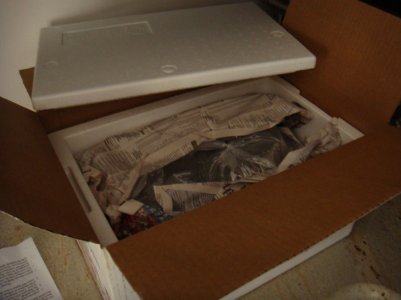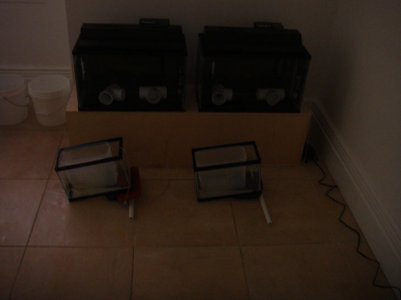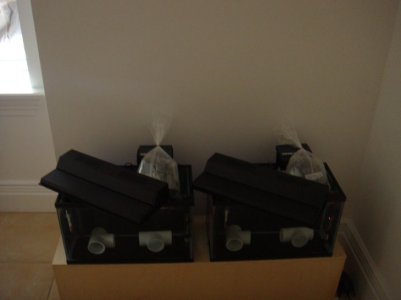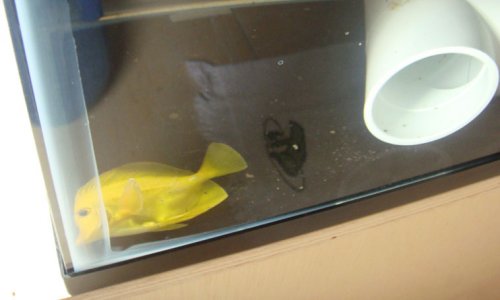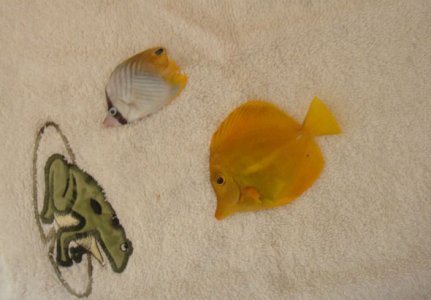schabiazabi
New member
I'm new to this hobby, and I'm having tons of problems, which I believe are due to my water being poisoned.
Long story short: In the beginning I did not have a RODI system, so I used tab water with Amquel Plus. I bought a Queen Angel and set her up using that very water. The fish is still alive. Since then, I bought a RODI system and purchased 3 fish from 2 different sources. They all died after acclamation. From 5 to 10 hours after.
During the last acclamation I wanted to perform a fresh water dip, but I could not adjust the PH up using Baking Soda (as suggested in the sticky post). Someone suggested my API test kit is wrong. This made me purchase a digital tester for multiple parameters. After testing PH in my tap water and my RODI water I found something very weird (at least to me, maybe it is normal). My RODI PH is much lower than my tab water PH. Here are the results of my water:
PH "“ Tab Water "“ 7.5
PH "“ RODI Water "“ 6.5 (or it changes around that range)
TDS "“ Tab Water "“ 260
TDS "“ RODI Water "“ 0
CON "“ Tab Water "“ 378
CON "“ RODI Water "“ 16
SAL "“ Tab Water "“ 190 ppm
SAL "“ RODI Water "“ 0 ppm
Ammonia 0
Nitrite 0
Is there a way to figure out if my water is correct based on the above parameters? The drop in PH and the dead fish worry me.
Is my RODI doing something to the water. I was suppose to flush it for 2 hours, which I did?
Also, if the above data is not enough to render a valid diagnosis, can you guys recommend a place where I can send my water for this kind of (fish related) testing.
More Data
0. Fish: Yellow Tang, Threadfin Butterfly, Majestic Angel
1. Temp is 78F
2. Drip Acclaim (almost 4 hours this time)
3. Fish from my LFS was eating. The last 2 I bought online. They did not eat after acclamation.
4. PH in my tank was 8.2 according to my API test kit.
5. No marks on Fish. The fish from my local store was perfect.
6. I did not clean around the tank. The first fish died on floor 4, and the last 2 fish died on floor 1. That rules out lots of environmental problems.
7. No chemicals, perfumes or anything like that.
8. I have a central AC, but I try not to run it in the winter up here in New York. You should not spray anything around your AC, so I did not.
Since I bought my RODI filter no fish was able to acclaim. I only have my fish from the tab water acclamation time (in the beginning). What throws me off the most is that my Queen Angel is in the same water (75%) now as the fish that died.
Can someone please comment on the PH drop after RODI. Is this normal. Why would the removal of metals increase the acidity? Is my RODI filter adding something to the water. When I was showing off my drinking water from the RODI my mother said "it feels something" when drinking.
The crual retest would be do buy two Butterflies again and acclaim one in the tab water with Amquel Plus and the other in plain RODI system water. I just do not want to do it.
For sure I'm not buying anything anymore until I understand what happens to my PH after RO.
The acclamation process is in the pictures.
Thanks in advance.
Long story short: In the beginning I did not have a RODI system, so I used tab water with Amquel Plus. I bought a Queen Angel and set her up using that very water. The fish is still alive. Since then, I bought a RODI system and purchased 3 fish from 2 different sources. They all died after acclamation. From 5 to 10 hours after.
During the last acclamation I wanted to perform a fresh water dip, but I could not adjust the PH up using Baking Soda (as suggested in the sticky post). Someone suggested my API test kit is wrong. This made me purchase a digital tester for multiple parameters. After testing PH in my tap water and my RODI water I found something very weird (at least to me, maybe it is normal). My RODI PH is much lower than my tab water PH. Here are the results of my water:
PH "“ Tab Water "“ 7.5
PH "“ RODI Water "“ 6.5 (or it changes around that range)
TDS "“ Tab Water "“ 260
TDS "“ RODI Water "“ 0
CON "“ Tab Water "“ 378
CON "“ RODI Water "“ 16
SAL "“ Tab Water "“ 190 ppm
SAL "“ RODI Water "“ 0 ppm
Ammonia 0
Nitrite 0
Is there a way to figure out if my water is correct based on the above parameters? The drop in PH and the dead fish worry me.
Is my RODI doing something to the water. I was suppose to flush it for 2 hours, which I did?
Also, if the above data is not enough to render a valid diagnosis, can you guys recommend a place where I can send my water for this kind of (fish related) testing.
More Data
0. Fish: Yellow Tang, Threadfin Butterfly, Majestic Angel
1. Temp is 78F
2. Drip Acclaim (almost 4 hours this time)
3. Fish from my LFS was eating. The last 2 I bought online. They did not eat after acclamation.
4. PH in my tank was 8.2 according to my API test kit.
5. No marks on Fish. The fish from my local store was perfect.
6. I did not clean around the tank. The first fish died on floor 4, and the last 2 fish died on floor 1. That rules out lots of environmental problems.
7. No chemicals, perfumes or anything like that.
8. I have a central AC, but I try not to run it in the winter up here in New York. You should not spray anything around your AC, so I did not.
Since I bought my RODI filter no fish was able to acclaim. I only have my fish from the tab water acclamation time (in the beginning). What throws me off the most is that my Queen Angel is in the same water (75%) now as the fish that died.
Can someone please comment on the PH drop after RODI. Is this normal. Why would the removal of metals increase the acidity? Is my RODI filter adding something to the water. When I was showing off my drinking water from the RODI my mother said "it feels something" when drinking.
The crual retest would be do buy two Butterflies again and acclaim one in the tab water with Amquel Plus and the other in plain RODI system water. I just do not want to do it.
For sure I'm not buying anything anymore until I understand what happens to my PH after RO.
The acclamation process is in the pictures.
Thanks in advance.

